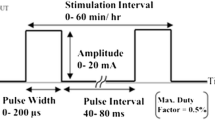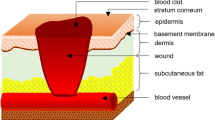Abstract
Chronic wounds are a major secondary complication for many people with impaired mobility. Electrical stimulation (ES) has been recommended as a adjunctive therapy, however optimal treatment paradigms have not been established. Our group seeks to determine the basic mechanisms underlying ES wound therapy, an area where understanding is currently limited. A feasibility study was carried out to develop the Ahn/Mustoe lapine wound model for systematic investigation of the effects of electrical stimulation on ischemic wound therapy. A standardized surgical procedure incorporated a hybrid stimulation system comprising an implantable mini-stimulator and surface electrodes, with creation of repeatable ischemic wounds. Twenty mature male New Zealand white rabbits (3 kg weight) were employed to evaluate the effects of two empirically selected stimulation paradigms applied continuously for 7–21 days, using each animal as its own control. Outcomes measures included transcutaneous blood gas levels, histology, total RNA content and analysis of α2 (I) collagen (COL-I), type IV collagen (COL-IV), α1 (V) collagen (COL-V), and vascular endothelial growth factor (VEGF) expression using real-time quantitative PCR. All markers for stimulated wounds showed increased activity relative to non-stimulated control wounds between 7 and 14 days following injury, with peak activity at 14 days. By 21 days post-injury, all activity had returned to near baseline level. VEGF and COL-IV levels were found to be significantly higher for pattern A (110 μs pulse width) compared to pattern B (5 μs pulse width) at 14 days, implying that pattern A may be more effective at promoting angiogenesis. All wounds were fully re-epithelialized by 10 days post-injury. Both COL-I and COL-V showed statistically significant (P < 0.05) increased activity between day 7 and day 14 for pattern A, potentially indicating a continued effect on matrix remodeling. The early closure of all wounds implies that the rabbit ear model may not be valid for chronic wound studies.


Similar content being viewed by others
References
Ahn ST, Mustoe TA (1990) Effects of ischemia on ulcer wound healing; a new model in the rabbit ear. Ann Plast Surg 24(1):17–23. doi:10.1097/00000637-199001000-00004
Akai M, Kawashima N, Kimura T, Hayashi K (2002) Electrical stimulation as an adjunct to spinal fusion: a meta-analysis of controlled clinical trials. Bioelectromagnetics 23(7):496–504. doi:10.1002/bem.10041
Assimacopoulos D (1968) Wound healing promotion by the use of negative electric current. Am Surg 34(6):423–431
Baker LL, Rubayi S, Villar F, Demuth SK (1996) Effect of electrical stimulation waveform on healing of ulcers in human beings with spinal cord injury. Wound Repair Regen 4:21–28. doi:10.1046/j.1524-475X.1996.40106.x
Beck LS, Chen TL, Hirabayashi SE, Deguzman L, Lee WP, McFatridge LL, Xu Y, Bates RL, Ammann AJ (1990) Accelerated healing of ulcer wounds in the rabbit ear by recombinant human transforming growth factor-beta 1. Growth Factors 2(4):273–282. doi:10.3109/08977199009078015
Bennett G, Dealey C, Posnett J (2004) The cost of pressure ulcers in the UK. Age Ageing 33(3):230–235. doi:10.1093/ageing/afh086
Bergstrom N, Allman RM, Alvarez OM, Bennett MA, Carlson CE, Frantz RA, Garber SL, Jackson BS, Kaminski MV, Kemp MG, Krouskop TA, Lewis VL, Maklebust J, Margolis DJ, Marvel EM, Reger SI, Rodeheaver GT, Salcido R, Xakellis GC, Yarkony GM (1994) Treatment of pressure ulcers. Clinical practice guideline, no. 15. Rockville. US Department of Health and Human Services. Public Health Service, Agency for Health Care Policy and Research. AHCPR Publication No. 95-0652. December 1994
Bogie KM, Reger SI, Levine SP (2000) Therapeutic applications of electrical stimulation: wound healing and pressure sore prevention. Assist Technol 12(1):50–66
Chen EA, Zhao L, Bamat M, von Borstel R, Mustoe T (1999) Acceleration of wound healing with topically applied deoxyribonucleosides. Arch Surg 134(5):520–525. doi:10.1001/archsurg.134.5.520
Clark RAF (1996) The molecular and cellular biology of wound repair, 2nd edn edn. Plenum Press, New York
Cullum N, Nelson EA, Flemming K, Sheldon T (2001) Systematic reviews of wound care management: (5) beds; (6) compression; (7) laser therapy, therapeutic ultrasound, electrotherapy and electromagnetic therapy. Health Technol Assess 5(9)
Feedar JA, Kloth LC, Gentzkow GD (1991) Chronic dermal ulcer healing enhanced with monophasic pulsed electrical stimulation. Phys Ther 71(9):639–649
Fray MJ, Dickinson RP, Huggins JP, Occleston NL (2003) A potent, selective inhibitor of matrix metalloproteinase-3 for the topical treatment of chronic dermal ulcers. J Med Chem 46(16):3514–3525. doi:10.1021/jm0308038
Gardner SE, Frantz RA, Schmidt FL (1999) Effect of electrical stimulation on chronic wound healing; a meta-analysis. Wound Repair Regen 7:495–503. doi:10.1046/j.1524-475X.1999.00495.x
Gould LJ, Leong M, Sonstein J, Wilson S (2005) Optimization and validation of an ischemic wound model. Wound Repair Regen 13(6):576–582. doi:10.1111/j.1524-475X.2005.00080.x
Ha X, Li Y, Lao M, Yuan B, Wu CT (2003) Effect of human hepatocyte growth factor on promoting wound healing and preventing scar formation by adenovirus-mediated gene transfer. Chin Med J (Engl) 116(7):1029–1033
Houghton PE, Kincaid CB, Lovell M, Campbell KE, Keast DH, Woodbury MG, Harris KA (2003) Effect of electrical stimulation on chronic leg ulcer size and appearance. Phys Ther 83(1):17–28
http://www.cms.hhs.gov/mcd/viewmcac.asp?from2=viewmcac.asp&where=index&mid=28&. Accessed 14 October 2008
Mustoe TA (2005) Dermal ulcer healing: advances in understanding. In: Proceedings of the tissue repair and ulcer/wound healing; molecular mechanisms, therapeutic targets and future directions. Institute Louis Pasteur, Paris, 17–18 March, 2005. Available online at http://www.pasteur.fr/applications/euroconf/tissuerepair/Mustoe_abstract.pdf
Rowley BA, McKenna JM, Wolcott LE (1974) Proceedings: the use of low level electrical current for enhancement of tissue healing. Biomed Sci Instrum 10:111–114
Russold M, Jarvis JC (2007) Implantable stimulator featuring multiple programs, adjustable stimulation amplitude and bi-directional communication for implantation in mice. Med Biol Eng Comput 45(7):695–699. doi:10.1007/s11517-007-0190-1
Tyrone JW, Mogford JE, Chandler LA, Ma C, Xia Y, Pierce GF, Mustoe TA (2000) Collagen-embedded platelet-derived growth factor DNA plasmid promotes wound healing in a dermal ulcer model. J Surg Res 93(2):230–236. doi:10.1006/jsre.2000.5912
Wu L, Siddiqui A, Morris DE, Cox DA, Roth SI, Mustoe TA (1997) Transforming growth factor beta 3 (TGF beta 3) accelerates wound healing without alteration of scar prominence. Histologic and competitive reverse-transcription-polymerase chain reaction studies. Arch Surg 132(7):753–760
Zhao M, Bai H, Wang E, Forrester JV, McCaig CD (2004) Electrical stimulation directly induces pre-angiogenic responses in vascular endothelial cells by signaling through VEGF receptors. J Cell Sci 117(3):397–405. doi:10.1242/jcs.00868
Acknowledgments
We would like to acknowledge Tom Stage and Jonathan Sakai of the Cleveland FES Center for invaluable technical device support. Lori Duesler and Teresa Pizzuto provided support in the development of the outcomes methodology; in particular we would like at thank Dr Tom Hering for his expert guidance. Material support for this study was provided through funding from the Ohio Board of Regents (Case Western Reserve University Presidential Research Initiative Grant).
Conflict of interest statement
The authors have no financial relationships that may pose a conflict of interest.
Author information
Authors and Affiliations
Corresponding author
Rights and permissions
About this article
Cite this article
Morris, K.A., McGee, M.F., Jasper, J.J. et al. Evaluation of electrical stimulation for ischemic wound therapy: a feasibility study using the lapine wound model. Arch Dermatol Res 301, 323–327 (2009). https://doi.org/10.1007/s00403-008-0918-2
Received:
Accepted:
Published:
Issue Date:
DOI: https://doi.org/10.1007/s00403-008-0918-2




